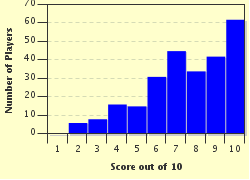Quiz Answer Key and Fun Facts
1. Number Two on Billboard, stuck behind "Hey Jude" for three weeks in 1968, this song turned the tables on that Beatles song by ousting it from the top of the British charts. What song featured this slice of lyric?
"Through the door there came familiar laughter
I saw your face and heard you call my name
Oh, my friend, we're older but no wiser
For in our hearts the dreams are still the same"
2. A group's debut release went right to Number Two on the Hot 100 in 1964, unable to dislodge "Mr. Lonely" by Bobby Vinton from the top of the chart. Only able to reach Number 12 in the U.K., can you identify the song which offers these descriptive lines?
"Well, let me tell you 'bout the way she looked
The way she acted, the color of her hair
Her voice was soft and cool, her eyes were clear and bright"
3. Number Two on Billboard for two weeks but struggling to Number 46 on the British chart in 1966, the following lyric sample should lead you to the correct answer. What song was this?
"I'm gonna keep my sheep suit on
Til I'm sure that you've been shown
That I can be trusted, walking with you alone"
4. "Coming to you on a dusty road
Good loving, I got a truck load
And when you get it, you got something
Don't worry, 'cause I'm coming"
This was the first stanza of a big Number Two hit from 1967 and I'd bet you'd have difficulties naming the song's title with just that for a clue. But if I added that the artists were Sam and Dave, can you identify it now?
5. This song first charted at Number Two on Billboard in 1961 but has made charting appearances a couple of times since, both on Billboard and in the U.K. as well. As such, the lyric sample I provide should have some resonance for you music lovers. What song was this?
"I thought that I was over you but it's true, so true
I love you even more than I did before"
6. The Newbeats, a group with only a handful of Hot 100 charting songs, hit the big time in 1964 with a Number Two hit that had plenty of food references. Here's but a brief example from the lyric.
"Got home early one morning and much to my surprise
She was eating chicken and dumplings with some other guy"
What song, also a Number 15 hit in Britain, was it?
7. "Seasons came and changed the time
And I grew up, I called him mine
He would always laugh and say
Remember when we used to play"
The next line reveals the title of this Number Two hit (Number Three in the U.K.) from 1965. So what were they playing?
8. Not many folk songs made it to the top of the Billboard Hot 100 during those few years when that genre was the rage but one came mighty close in 1963 coming up one spot short. In the U.K., it peaked at Number 13.
"How many seas must the white dove sail
Before she sleeps in the sand?
Yes and how many times must the cannonballs fly
Before they are forever banned?"
And the answer is, my friend?
9. A real rockin' little number couldn't overcome Gene Chandler's "Duke Of Earl" for Number One in 1962. Content with the runner-up spot on the Hot 100 and stalling a little farther down the chart in Britain at Number 10, the song could have had auto-biographical nuances. Here's your lyrical clue, you identify the song.
"Well I'm the type of guy who will never settle down
Where pretty girls are, well, you know that I'm around
I kiss 'em and I love 'em 'cause to me they're all the same
I hug 'em and I squeeze 'em, they don't even know my name"
10. 1967 marked the year that a member of a noted musical family from New Orleans, the Neville Brothers, made a Billboard Hot 100 breakthrough with a Number Two hit and it would be a very long time before he'd be able to do it again. Consider those clues, tie them up with the accompanying lyric sample and give me the correct answer.
"If you want something to play with
Go and find yourself a toy
Baby my time is too expensive
And I'm not a little boy"
Source: Author
maddogrick16
This quiz was reviewed by FunTrivia editor
kyleisalive before going online.
Any errors found in FunTrivia content are routinely corrected through our feedback system.

